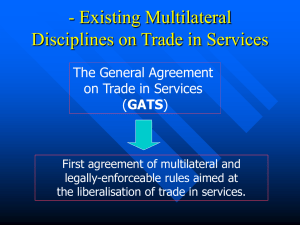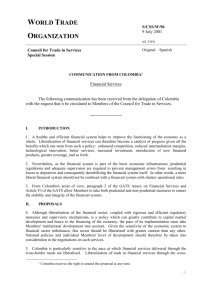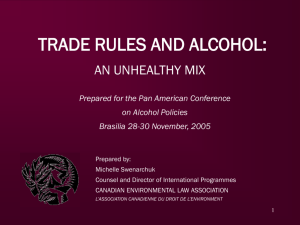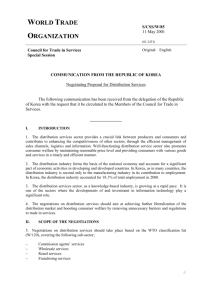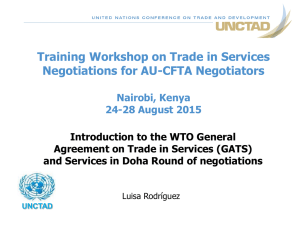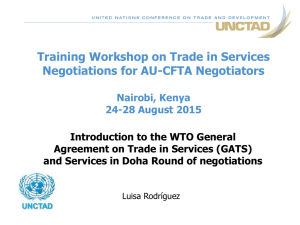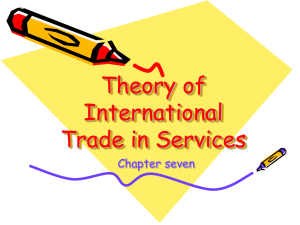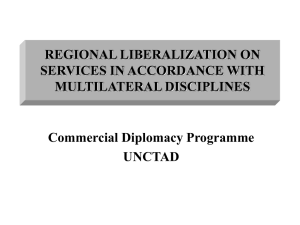Developing Countries in the New Round of GATS Negotiations:
advertisement
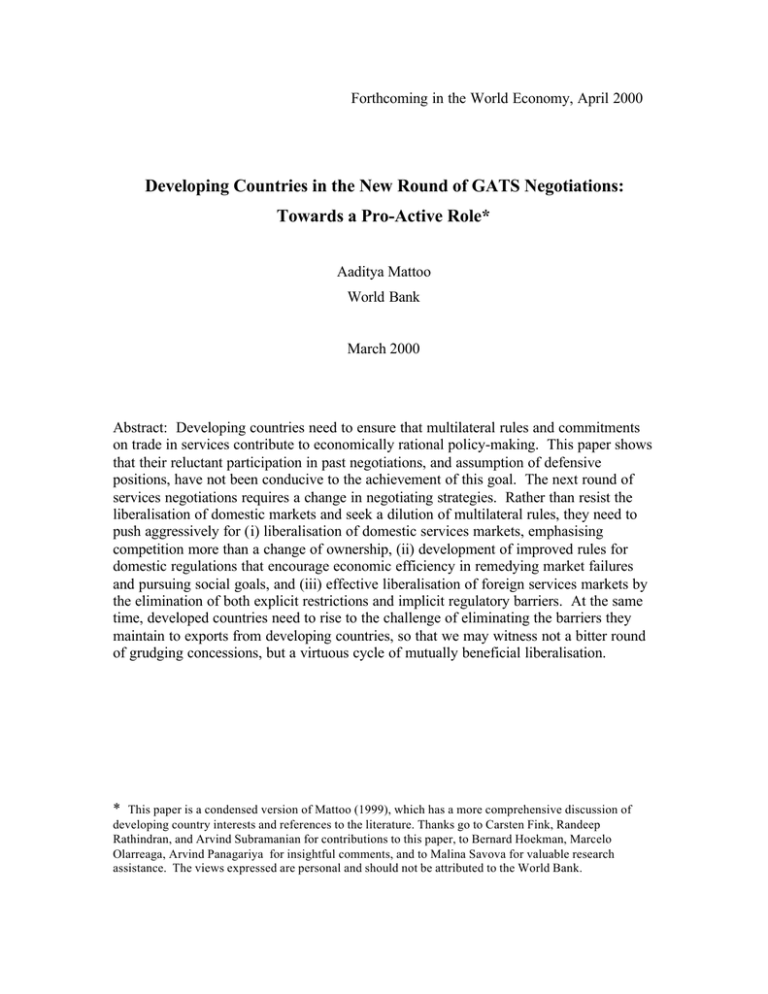
Forthcoming in the World Economy, April 2000 Developing Countries in the New Round of GATS Negotiations: Towards a Pro-Active Role* Aaditya Mattoo World Bank March 2000 Abstract: Developing countries need to ensure that multilateral rules and commitments on trade in services contribute to economically rational policy-making. This paper shows that their reluctant participation in past negotiations, and assumption of defensive positions, have not been conducive to the achievement of this goal. The next round of services negotiations requires a change in negotiating strategies. Rather than resist the liberalisation of domestic markets and seek a dilution of multilateral rules, they need to push aggressively for (i) liberalisation of domestic services markets, emphasising competition more than a change of ownership, (ii) development of improved rules for domestic regulations that encourage economic efficiency in remedying market failures and pursuing social goals, and (iii) effective liberalisation of foreign services markets by the elimination of both explicit restrictions and implicit regulatory barriers. At the same time, developed countries need to rise to the challenge of eliminating the barriers they maintain to exports from developing countries, so that we may witness not a bitter round of grudging concessions, but a virtuous cycle of mutually beneficial liberalisation. * This paper is a condensed version of Mattoo (1999), which has a more comprehensive discussion of developing country interests and references to the literature. Thanks go to Carsten Fink, Randeep Rathindran, and Arvind Subramanian for contributions to this paper, to Bernard Hoekman, Marcelo Olarreaga, Arvind Panagariya for insightful comments, and to Malina Savova for valuable research assistance. The views expressed are personal and should not be attributed to the World Bank. Developing countries need to ensure that multilateral rules and commitments on trade in services contribute to economically rational policy-making at the national and international levels. Their reluctant participation in past negotiations has not been conducive to the achievement of this goal. The next round of services negotiations requires a change in negotiating strategies. Rather than resist the liberalisation of domestic markets and seek a dilution of multilateral rules, they need to push aggressively for the liberalisation of both domestic and foreign services markets and to promote the development of improved rules. At the same time, developed countries must rise to the challenge of eliminating the barriers they maintain to exports from developing countries, so that we may witness a virtuous cycle of mutually beneficial liberalisation. A number of basic themes emerge from this paper and related research on services trade liberalization. There are substantial gains both from liberalization within developing countries, especially in key infrastructure services like telecommunications, transport and financial services, and from the elimination of barriers to their exports. Successful domestic liberalization requires greater emphasis on introducing competition than changing ownership; regulation to remedy market failure and pursue legitimate social goals with economic efficiency; and credibility of policy reform programs. Effective access to foreign markets requires the elimination of explicit restrictions as well as disciplines on implicit regulatory barriers. A central question in preparing for the next round of services negotiations is how the GATS can help achieve these objectives. This paper discusses why liberalisation of trade in services should lead to improved economic performance; argues that certain policy choices developing countries made in key services sectors, often under negotiating pressure, were not socially desirable; discusses the substantial gains that could arise from the elimination of the barriers to developing country service exports; proposes a possible formula for breaking the stalemate on the movement of individual service providers; and demonstrates how appropriately designed GATS rules on domestic regulations can help both to promote reform at the national level and meaningful market access at the international level. 1 Table 1 provides a summary of the issues discussed in this paper, their current status and what seem to be the desirable outcomes. I. The benefits of liberalising trade in services Restrictions on trade in services, as on trade in goods, reduce the level of real GDP which is equivalent to a loss in welfare. 1 In the case of services, there is an additional twist in that many services are inputs into production and inefficient production of such services acts as a tax on production. Thus, goods trade liberalization in the absence of service liberalization could well result in negative effective protection for goods, highlighting the need for the latter to keep pace with the former. 2 Well functioning service industries contribute to growth in different ways. An efficient financial sector allows resources to be deployed where they have the highest returns. King and Levine (1993) demonstrate that efficient financial services contribute to and precede faster economic growth. Improved telecom efficiency generates economywide benefits as telecommunications are a vital intermediate input and are crucial to the diffusion of knowledge. Similarly, transport services contribute to the efficient distribution of goods within a country, and greatly influence a country’s ability participate in global trade. Business services such as accounting and legal services are important in reducing transaction costs; education and health services are necessary in building up the stock of human capital, a key ingredient in long run growth performance. Services and goods liberalization differ in some key respects. In services, attaining efficiency is not just a matter of liberalizing trade barriers, but also of instituting an appropriate domestic regulatory framework. Services liberalization also entails, in most instances, movement of factors of production. A country that liberalizes its services sector is likely to augment its stock of capital (through increased FDI) and crucially the stock of human capital and technology that is embodied in or associated with such FDI. The impact of this on long run growth is unambiguously positive. Furthermore, there is evidence that FDI is more productive that domestic investment (e.g., Borenzstein et al 1 2 The restriction creates a wedge between domestic and foreign prices, leading to a loss in consumer surplus that is greater than the gain in producer surplus arising from higher domestic production. See e.g., Hoekman and Braga (1997), Findlay and Warren (1999), and Hoekman and Djankov (1997). 2 1998), indicating the presence of positive technology spillovers. This is as true for developing country capital importers as for developed country importers of skilled labor services. The contribution of imported skilled labor to the high-technology sectors in the US is now widely recognized. Studies examining the link between liberalization of trade in goods and growth are as profuse as those on the services-growth link are sparse. This reflects in part the complexity of services sectors, especially the difficulty in encapsulating the multiplicity of restrictions in easily quantifiable and comprehensible indices. An important research priority is to replicate the trade in goods-growth studies for services, while controlling for other determinants of growth. As a first step in filling this gap, Mattoo, Rathindran, and Subramanian (1999) have constructed openness indices for two services sectors— telecommunications and financial services—and introduced these in standard crosscountry growth regressions. Although preliminary, the results suggest the partial correlations between financial services liberalization and growth found by e.g., Claessens and Glaessner (1998) and Francois and Schuknecht (1998) are robust: liberalization contributes meaningfully to explaining cross-country growth performance. II. Choosing the Pattern of Liberalisation a. Entry and Ownership Restrictions on foreign commercial presence assume particular significance in the case of services where cross-border delivery is not possible, so that consumer prices depend completely on the domestic market structure. Restrictions on new entry and on the participation of foreign capital are the most common, particularly in communications and financial services (Table 2). A basic conclusion from the literature on privatization is that larger welfare gains arise from an increase in competition than from simply a change in ownership from public to private hands. In the GATS context countries have often conceded increased “market access” under pressure from trading partners in the form of increased foreign ownership of existing domestic firms, rather than by allowing new entry. Considerable negotiating energy was also devoted to maintaining existing foreign 3 ownership (Mattoo, 1999). This trend was particularly visible in the financial services negotiations, where the so called “grandfather provisions” guaranteed ownership and branching rights of incumbent foreign firms while far more limited rights were assured for potential entrants, potentially placing them at a competitive disadvantage. Foreign investment clearly brings benefits even in situations where it does not lead to enhanced competition (i.e., there are entry restrictions). Foreign equity may relax a capital constraint, can help ensure that weak domestic firms are bolstered (e.g. via recapitalizing financial institutions), and serve as a vehicle for transferring technology and know-how, including improved management. However, if FDI comes simply because the returns to investment are artificially raised by restrictions on competition, the net returns to the host country may be negative (returns to the investor may exceed the true social productivity of the investment—Hindley and Smith, 1984). To some extent the rent appropriation may be prevented by profit taxation or by holding competitive auctions of licenses or equity, but the static and dynamic inefficiencies from lack of competition would still exist. 3 Given the existence of rent-generating restrictions on competition, it is possible to rationalize the observed limitations on foreign ownership as seeking to balance the efficiency-enhancing and the rent-appropriation aspects of foreign investment. However, this still leaves the question why we observe such widespread restrictions on entry. While it is possible to construct special models of market and/or regulatory failure where entry barriers enhance welfare, 4 restrictions generally aim to protect the incumbent suppliers (not necessarily national) from immediate competition for infant industry type reasons, to facilitate "orderly exit" or simply because of political economy pressures. Monopolistic or oligopolistic rents may also be seen as a means to allow firms to fulfil universal service obligations. Both of these arguments are considered further below. In some cases a form of "investment pessimism" exists, leading to the belief that promises of oligopoly rents are necessary to attract new investment. However, it is not clear why the market structure 3 4 And, neither addresses appropriation by existing foreign share owners. In this context, grandfathering commitments assume particular significance. One example is excessive entry by firms that are ignorant of each others costs; the social benefits of competition between firms may then outweigh the social costs of duplication of investment. 4 needs to be determined by policy, unless there are some initial investments the benefits of which may be appropriated by rivals. Finally, governments may seek to raise revenue (or rents for politicians/bureaucrats) by auctioning monopoly or oligopoly rights. This amounts to indirect appropriation of consumers' surplus. But the static and dynamic inefficiencies consequent upon lack of competition would still exist. Entry restrictions are becoming harder to justify in the face of growing evidence of the benefits of competition. In Latin America, for example, countries that granted monopoly privileges of six to ten years to the privatized state enterprises saw connections grow at 1.5 times the rate achieved under state monopolies but only half the rate in Chile, where the government retained the right to issue competing licenses at any time (Wellenius, 1997). Mattoo (1999) finds a significant negative relationship between performance (measured by price and quality indicators) and the number of firms and the existence of an independent regulator, and generally a weaker relationship with the share of public and foreign ownership. These results support the view that the consumer benefits arise more from increased competition and effective regulation than from a change in ownership. b. Precommitment to future liberalization One reason governments may be reluctant to liberalize immediately is a perceived need to protect the incumbent suppliers from competition—either because of infant industry type arguments or to facilitate "orderly exit." One reason for the failure of infant industry policies in the past, and the innumerable examples of perpetual infancy, was the inability of a government to commit itself credibly to liberalize at some future date. The GATS offers a valuable mechanism to overcome the credibility difficulty. Governments can make binding commitments to provide market access and national treatment at a future date. Failure to honour these commitments would create an obligation to compensate those who are deprived of benefits, making the commitment more credible than a mere announcement of liberalizing intent in the national context. A precommitment to liberalize can also instill a sense of urgency in domestic reform, and in efforts to develop the necessary regulatory and supervision mechanisms. 5 Several governments have taken advantage of the GATS to strike a balance between their reluctance to unleash competition immediately on protected national suppliers and their desire not to be held hostage in perpetuity either to the weakness of domestic industry or to pressure from vested interests. The most striking examples are in basic telecommunications, where a number of developing countries have bound themselves to introduce competition at precise future dates. The use of the GATS as a mechanism for lending credibility to liberalization programmes has been disappointing in other sectors. III. Services exports of developing countries a. Potential gains and current barriers There are likely to be significant gains world-wide if restrictions on services exports from developing countries are eliminated. With greater liberalisation, particularly in mode 4—movement of natural persons—many more developing countries could “export” at least the significant labour component of services such as construction, distribution, environmental and transport. One of the most striking recent examples of a developing country service export success story is the Indian software industry, which has emerged as a significant supplier to developed country markets. Indian software exports grew from US$225 million in 1992-93 to US$ 1.75 billion in 1997-98 (at a compound annual growth rate of approximately 50 percent). 5 Some elements of this story are note worthy. First, despite the growing importance of cross-border electronic delivery of software services, the movement of natural persons remains a crucial mode of delivery. Even though the share of on-shore services in total Indian software exports has been in continuous decline (in 1988, the percentage of on-site development was almost as high as 90 percent), about 60 percent of Indian exports are still supplied through the temporary 5 See the National Association of Software and Service Companies (NASSCOM) website <http://www.nasscom.org>. These exports consist mainly of standardized coding and testing services. 6 movement of programmers, i.e. services are delivered on-shore, at the client’s site overseas. 6 Secondly, it cannot be assumed that other countries’ trade policies will become progressively more liberal, particularly with regard to movement of persons. In the early 1990s, the U.S. government introduced rules that obliged foreign workers to acquire temporary work visas (H1-B visas), and limited the number of visas issued during a year to 65,000. This contributed to the relative decline of on-shore services by Indian firms (Heeks, 1998). In 1998, in response to mounting labor shortages experienced in the U.S. IT sector, the annual visa cap was raised to 115,000 for both 1999 and 2000. This quota increase is likely to lead to a boost in U.S. on-site imports of software services, especially as they relate to “Year 2000” work. The question is whether liberalization will continue after the “Year 2000” problem has been resolved. Third, significant gains can be had from further liberalization. There are wide differences in the cost of software development and support: the average cost per line of code in Switzerland (the most expensive country) exceeds by more than five times that of India (the cheapest country); average salaries are more than eleven times higher in Switzerland (Mattoo, 1999). Even though differences in labor productivity imply that a lower average salary of programmers may not necessarily translate into a lower average cost per line of software code, by outsourcing programming activities firms in developed countries can significantly save on development and support costs. Against the background of a total market for software services worth about US$ 58 billion in the United States, US$ 42 billion in Europe and US$ 10 billion in Japan, such cost savings could well be substantial. 7 Other gains from trade liberalization for importing countries include a more competitive market structure for software services, increased choice, as countries may develop a special expertise for certain development or support services, and greater diffusion of knowledge. 6 See http://www.nasscom.org. The dominance of on-shore delivery is due to inter alia a reduction in information asymmetries with regard to the performance of programmers, need for continuous clientdeveloper interaction, and demands by Indian programmers to be sent abroad, in part to improve their skills and expose themselves to international markets (see Heeks, 1998). 7 These figures were computed from WTO (1998), Table 3. Data refer to 1997. 7 Health services are another area in which developing countries could become major exporters, either by attracting foreign patients to domestic hospitals and doctors, or by temporarily sending their health personnel abroad. In Cuba, the government’s strategy is to convert Cuba into a world medical power. SERVIMED, a trading company created by the government, prepares health/tourism packages. During 1995/96 25,000 patients and 1,500 students went to Cuba for treatment and training respectively, and income earned from sales to health services to foreigners was US$ 25 million. Again, cost savings for patients and health insurers can be significant. For instance, the cost of coronary bypass surgery could be as low as Rs 70,000 to 100, 000 in India, about 5% of the cost in developed countries. Similarly, the cost of a liver transplant is one-tenth of that in the United States (United Nations and WHO, 1998). A major barrier to consumption abroad of medical services is the lack of portability of health insurance. For instance, US federal or state government reimbursement of medical expenses is limited to licensed, certified facilities in the United States or in a specific American state. The lack of long-term portability of health coverage for retirees from OECD countries is also one of the major constraints to trade. In the United States for instance, Medicare covers virtually no services delivered abroad. Other nations may extend coverage abroad, but only for limited periods such as two or three months. This constraint is significant because it tends to deter some elderly persons from travelling or retiring abroad. And those who do retire abroad are often forced to return home to obtain affordable medical care. The potential impact of permitting portability could be substantial. If only 3 percent of the 100 million elderly persons living in OECD countries retired to developing countries, they would bring with them possibly US$30 to 50 billion annually in personal consumption and $10 to 15 billion in medical expenditures (United Nations and WHO, 1998). Many different barriers constrain the movement of natural persons. The many formalities alone (e.g. to obtain a visa) make red tape related to FDI seem trivial by comparison. The most obvious barriers are explicit quotas and/or economic needs tests, e.g., requirements that employers take timely and significant steps to recruit and retain sufficient national workers in the speciality occupation and that no worker has been laid off for a certain period preceding and following the filing of any work permit or visa 8 application. 8 Qualification and licensing requirements and the regulations of professional bodies are major barriers as well. The entry of foreigners can be impeded by nonrecognition of their professional qualifications, burdensome licensing requirements or by the imposition of discriminatory standards on them. The requirement of registration with, or membership of, professional organisations can also constitute an obstacle for a person wishing to provide the service on a temporary basis b. Using the GATS negotiations to enhance market access There is no doubt that the Uruguay Round outcome in services was unbalanced. The much-touted trade-off between modes of delivery simply did not take place. Although antipathy to commitments on labor mobility in partner countries was a major contributing factor, an unwillingness on the part of developing countries to open up domestic services markets made their demands for labor mobility difficult to sustain. With developing countries opening up their markets, the prospects for serious inter-modal trade-offs are greater now—e.g., liberalization of labor movement in return for allowing greater commercial presence for foreign service providers. Severe shortages of skilled labor in the US and the powerful constituency of high-technology companies lobbying for relaxation of visa limits also makes this a propitious time to put labor mobility squarely on the negotiating agenda. 9 It would seem to be in the interest of all countries to separate clearly temporary movement from migration, and to push for liberalisation only with respect to the former. For exporting countries, it is clear that both the financial and knowledge benefits would be greatest if service suppliers (particularly those who have benefited from a subsidised 8 Other barriers to movement of natural persons include double taxation, wage-matching requirements (wages paid to foreign workers should be the similar to those paid to nationals in that profession, eliminating the cost advantage for foreigners), and local training requirements (to replace foreign with national labour within a certain time frame). 9 The notions of the US as the unrivaled centre of technology and the role of technological progress in motoring the recent US economic expansion resonate deeply with the US public. They would therefore be loath to countenance any obstacles to this march of progress even if it involves greater imports of labor-related services. 9 education) return home after a certain period abroad. 10 And for importing countries, such temporary movement should create fewer social and political problems than immigration. One option to extract meaningful mode 4 commitments would be to require a country to provide increased “foreign labour content entitlements” to their domestic firms in relation to the country’s increased exports of services. 11 The requirement would be internationally symmetric: all countries would be obliged to create such entitlements, though how much they are used would be determined by sound economic considerations of modal comparative advantage. Entitlements would not be bilateral, but international. This approach is also based on a balance of concessions, an appealing principle in trade negotiations. Exporters of labor services would receive benefits commensurate with efforts to open up their domestic services markets. The scheme would also generate a desirable liberalizing momentum. Conventional mercantilist negotiations on trade barriers create a holdback problem: I would rather give less to get more from you. By linking my export possibilities to your actual exports, the proposed scheme induces me to be more open. c. Ensuring barrier-free electronic commerce Electronic commerce offers an increasingly viable alternative to the movement of individuals. WTO Members have decided that for the moment electronic delivery of products will continue to be free from customs duties. There are proposals to make this decision permanent. Fortunately most electronic commerce is already free of barriers (except of course those created by differences in standards), and so the objective is really to preclude the introduction of new barriers. But is duty-free electronic commerce the appropriate route? 10 Over 50% of all migrating physicians come from developing countries. In Ethiopia, for example, during 1984-94, 55.6 per cent of the pathology graduates from the Addis Ababa Faculty of Medicine left the country. In Ghana, of the 65 who graduated from the Medical School in 1985, only 22 remained in the country by 1997. If these countries had adequate medical staff at home, these figures would be less cause for concern. 11 Mattoo and Olarreaga (2000). In a way Bill Gates’ recent testimony before congress arguing for the need to allow more software engineers to enter to maintain international competitiveness is not far-removed from the suggested scheme. 10 Liberating ecommerce from duties is either superfluous or virtually devoid of value. Since the bulk of such commerce concerns services, the relevant regime is that established by the GATS regime on cross-border trade. The GATS allows countries to decide whether to commit to market access, i.e. not to impose quotas, and to national treatment, i.e. not to discriminate in any way against foreign services and suppliers. If a country has already made such a commitment, then any further promise not to impose duties is superfluous because customs duties inherently discriminate against foreign services. If a country has not made such a commitment, then the promise not to impose customs duties is worth little, because a country remains free to impede access through discriminatory internal taxation – which has been carefully excluded from the scope of the decision. Worse the prohibition of such duties, may induce recourse to quotas which are ironically still permissible in spite of being economically inferior instruments. Hence, the focus on duty-free treatment is misplaced. The objective should rather be to push trading partners into making deeper and wider commitments under the GATS on crossborder trade regarding market access (which would preclude quantitative restrictions) and national treatment (which would preclude all forms of discriminatory taxation). Table 3 summarizes the current state of commitments on cross-border supply in some of the areas in which developing countries have an export interest. In software implementation and data processing, of the total WTO Membership of over 130, only 56 and 54 Members, respectively, have made commitments; and only around half of these commitments guarantee unrestricted market access, and a similar proportion guarantee unqualified national treatment. In all professional services, there are commitments from 74 Members, but less than a fifth assure unrestricted market access and national treatment, respectively. There clearly remains considerable scope for widening and deepening commitments. IV. Dealing with domestic regulations Developing countries have much to gain from strengthened multilateral disciplines on domestic regulations. The development of such disciplines can play a significant role in promoting and consolidating domestic regulatory reform. The telecommunications experience is a powerful example of this possibility. Such disciplines can also equip 11 developing country exporters to address regulatory barriers to their exports in foreign markets. 12 For instance, unless disciplines are developed to deal with licensing and qualification requirements for professionals, market access commitments on mode 4 will have only notional value. However, there are limits to what can be achieved at the multilateral level, and some of the key regulatory challenges must still be addressed at the national level. This is because multilateral trade rules are designed to ensure market access, and not directly to promote economic efficiency or social welfare. One of the ironies of the GATS is that among its weakest provisions are those dealing with domestic regulations, which have such an obviously powerful influence on international trade in services. The reason is not difficult to see: it is extremely difficult to develop effective multilateral disciplines in this area without seeming to encroach upon national sovereignty and unduly limiting regulatory freedom. Nevertheless, it is desirable and feasible to develop horizontal disciplines for domestic regulations. 13 The diversity of services sectors, and the difficulty in making certain policy-relevant generalizations, has tended to favour a sector-specific approach. However, even though services sectors differ greatly, the underlying economic and social reasons for regulatory intervention do not. And focusing on these reasons provides the basis for the creation of meaningful horizontal disciplines. Such a generic approach is to be preferred to a purely sectoral approach for at least three reasons: it economizes on negotiating effort, leads to the creation of disciplines for all services sectors rather than only the politically important ones, and reduces the likelihood of negotiations being captured by sectoral interest groups. It is now widely recognized that the most dramatic progress in the EU single-market programme came from willingness to take certain broad cross-sectoral initiatives. In the WTO context, the experience of the accountancy negotiations shows the propensity for single sectoral negotiations on domestic regulations to produce a weak outcome. Even if a horizontal approach is desirable, is it feasible? The economic case for regulation in all services sectors arises essentially from market failure attributable 12 13 These gains, of course, imply a cost: giving up domestic regulatory discretion. But if multilateral disciplines are desirable then this cost is no different from the first benefit identified above. What follows draws upon Gamberale and Mattoo (1999). 12 primarily to three kinds of problems, natural monopoly or oligopoly, asymmetric information, and externalities. Market failure due to natural monopoly or oligopoly may create trade problems because incumbents can impede access to markets in the absence of appropriate regulation. Because of its direct impact on trade, this is the only form of market failure that needs to be addressed directly by multilateral disciplines. The relevant GATS provision, Article VIII dealing with monopolies, is limited in scope. As a consequence, in the context of the telecom negotiations, the reference paper with its competition principles was developed in order to ensure that monopolistic suppliers would not undermine market access commitments (Tuthill, 1997). These principles should be generalized to a variety of other network services, including transport (terminals and infrastructure), environmental services (sewage) and energy services (distribution networks), by ensuring that any major supplier of essential facilities provides access to all suppliers, national and foreign, at cost-based rates. At the same time, there is a need to strengthen Article IX to deal with international cartels (e.g. in transport services) which cannot be adequately addressed through national competition policy. In all other cases of market failure, multilateral disciplines do not need to address the problem per se, but rather to ensure that domestic measures to deal with the problem do not serve unduly to restrict trade. (The same is true for measures designed to achieve social objectives.) Such trade-restrictive effects can arise from a variety of technical standards, prudential regulations, and qualification requirements in professional, financial and numerous other services; as well as from the granting of monopoly rights to complement universal service obligations in services like transport and telecommunications. The trade-inhibiting effect of this entire class of regulations is best disciplined by complementing the national treatment obligation with a generalization of the so-called "necessity" test. This test leaves governments free to deal with economic and social problems provided that any measures taken are not more trade restrictive than necessary to achieve the relevant objective. This test is already part of the recently established disciplines in the accountancy sector. It is desirable to use it to create a presumption in favour of economically efficient choice of policy in remedying market failure and in pursuing non-economic objectives (Mattoo and Subramanian, 1998). For 13 instance, in the case of professionals like doctors, a requirement to re-qualify would be judged unnecessary, since the basic problem, inadequate information about whether they possess the required skills, could be remedied by a less burdensome test of competence. In sum, the telecommunications and accountancy models, suitably developed and generalized, can together ensure that domestic regulations achieve their objectives without sacrificing economic efficiency. This is not to say that there is no need for sector-specific disciplines. For instance, there is valuable work that could be done to establish how best to deal with asymmetric information and differences in standards between countries. But we can make a useful beginning by taking a cross-sectoral approach. Such a route is particularly desirable because at the multilateral level, harmonization and mutual recognition are not meaningful alternatives to the application of a necessity test – even though they can play a role at the regional or plurilateral level. The pessimism with regard to harmonization is based on the absence of widely accepted international standards in services. 14 With regard to mutual recognition agreements (MRAs), it would seem that even in strongly integrationist Europe, despite a significant level of prior harmonization, the effect of MRAs may have been limited by the unwillingness of host country regulators to concede complete control (Nicolaidis and Trachtman, 1999). In any case, MRAs are like sectorspecific preferential arrangements, and can have similar trade-creating trade-diverting effects. Multilateral disciplines must be used to ensure that MRAs are not used as a means of discrimination and exclusion. 15 Otherwise, their result may well be to create trade according to patterns of mutual trust rather than the pattern of comparative advantage. 14 15 Where such standards exist, as in banking or maritime transport, meeting them is seen as a first step towards acceptability, rather than as a sufficient condition for market access. These disciplines operate at two levels: the general rules on preferential arrangements and the specific rules for MRAs. Article V on integration agreements does not explicitly preclude MRAs, and several countries have chosen to notify their MRAs under this provision. However, Article VII of the GATS dealing specifically with recognition, strikes a delicate balance by allowing such agreements, provided they are not used as a means of discrimination and third countries have the opportunity to accede or demonstrate equivalence. It should be clarified that this provision, with its desirable nondiscriminatory and open-ended nature, overrides Article V of the GATS as far as MRAs are concerned. 14 The development of multilateral disciplines is in no way a substitute for strengthening domestic regulatory mechanisms and institutions. At least three areas are of considerable importance. (i) Dealing with monopolies The telecom Reference Paper illustrates both the strengths and the limitations of the multilateral approach. The primary concern of the paper, as of WTO rules in general, is to ensure effective market access, and hence the focus on the terms of interconnection. Wider concerns about consumer interests and how they may be affected by monopolistic behaviour are not addressed by the Paper. While there can be little doubt that price determination is ideally left to competitive markets, and regulatory price setting is fraught with difficulties, yet regulatory authorities in developing countries where competition is slow to develop need to equip themselves, legally and technically, with the ability to regulate prices. 16 This would seem particularly desirable in countries like some of those in the Caribbean, which have locked themselves into exclusive supply contracts with a single telecom provider well into the next century. Importantly, while nothing in the GATS prevents a country from pursuing any form of pro-competitive regulation provided it is not discriminatory, the capacity of most developing countries to exercise such regulation is limited. (ii) Dealing with asymmetric information The need for effective regulation of financial services needs no elaboration, particularly in light of the recent experiences of many countries. Again it is incumbent on the countries themselves to create adequate mechanisms for such regulation. And such regulation is clearly necessary to benefit fully from liberalization. Other areas where the inadequacy of regulatory mechanisms to deal with asymmetric information is a problem have received relatively less attention. For instance, in professional services, low standards and disparities in domestic training and examinations can become a major 15 impediment to obtaining foreign recognition. Thus inadequacies in domestic regulation can legitimize external barriers to trade. A further twist is that domestic consumers may actually prefer cheap, low quality products. The question of how best to achieve the needs of export markets given domestic preferences for quality is clearly an area where much more research is needed. (iii) Achieving universal service and non-economic objectives Attaining social objective in an economically efficient manner is a major challenge for national policy-makers. The manner in which they pursue this objective can have a profound impact on trade in a variety of areas, ranging from financial, transport, telecommunications, health and education services. Interestingly, the telecom Reference Paper acknowledges the right of a country to define universal service obligations provided they are administered in a transparent, non-discriminatory and not excessively burdensome manner. But it does not prescribe the appropriate means to achieve this objective – this is left to national governments. Historically, governments frequently relied on public monopolies to pursue (often unsuccessfully) universal services objectives, either through cross-subsidization across different segments of the market, or through transfers from the government or government-controlled banks. In addition to the inefficiencies created by monopolistic market structures, the burdens imposed by these obligations on existing national suppliers are even now a major impediment to liberalization in many countries. For instance, domestic banks saddled with bad debts because of past directed-lending programmes are not well equipped to deal with foreign competition. Nevertheless, the current handicap of universal service obligations can in principle also be imposed on new entrants. Thus, such obligations were part of the license conditions for new entrants into fixed network telephony and transport in several countries. But as in many other cases, recourse to fiscal instruments has proved more successful than direct regulation. For instance, in Chile, government subsidies equivalent to less than 0.5 percent of total telecommunications revenue, allocated through 16 In many developed country markets where fully competitive conditions have not been established, such as the telecommunications sector in the United Kingdom, the final price itself has been regulated. 16 competitive bidding in 1995, mobilized 20 times as much private investment to extend basic telephone services to rural areas (Wellenius, 1997). A third instrument is to fund the consumer rather than the provider (Cowhey and Klimenko, 1999). Governments have experimented with various forms of vouchers, from education to energy services. This last instrument has at least three advantages: it can be targeted directly at those who need the service and cannot afford it; it avoids the distortions that arise from artificially low pricing of services to ensure access; and finally, it does not discriminate in any way between providers. V. Conclusion Although the most important services policy reforms need to be taken at the domestic level, there is substantial scope for constructive use of the multilateral trading system both in realising credible domestic liberalization and securing market access abroad. This paper has discussed some of the major issues confronting developing countries—a more comprehensive treatment can be found in Mattoo (1999). Major recommendations are summarised in Table 1 above. Certain policy choices made by developing countries, often under negotiating pressure, are not likely to maximise domestic welfare. Examples emphasised in this paper were “market access” concessions that allow increased foreign ownership of existing firms rather than new entry, and guarantee the privileged status of foreign incumbents. Furthermore, where the immediate introduction of competition was not feasible, too little advantage has been taken of the GATS to lend credibility to future liberalisation plans. Persistent barriers to services exports of developing countries are depriving the world of substantial welfare gains. These barriers include explicit quotas whose elimination or relaxation must be negotiated directly, and implicit regulatory hurdles that must be dealt with by strengthening GATS rules on domestic regulations. In particular, efforts must be made to break the stalemate on the movement of individual service providers – creating “foreign labour content entitlements” is one possibility. It is also desirable to enhance the security of market access for electronic delivery of services. This is best accomplished by widening and deepening the scope of GATS commitments on 17 cross-border delivery, rather than by perpetuating the current WTO decision on duty-free treatment for electronically delivered products. One of the ironies of the GATS is that provisions dealing with domestic regulations are among its weakest, even though they have an obviously powerful influence on international trade in services. Appropriately designed GATS rules on domestic regulations (on which negotiations have already begun) can serve a valuable dual purpose, helping both to promote reform at the national level and meaningful market access at the international level. 18 Bibliography Adlung, Rudolf, A. Carzeniga, and A. Mattoo. 1999. “The Pattern of Restrictions in GATS Schedules,” WTO, mimeo. Borenzstein, E., J. D. Grigorio and J. W. Lee, 1998, "How Does Foreign Direct Investment Affect Economic Growth?" Washington, D.C.: IMF. Claessens, Stijn and Tom Glaessner, 1998, “Internationalization of Financial Services in Asia,” World Bank, mimeo. Cowhey, Peter and Mikhail M. Klimenko, 1999, ,“The WTO Agreement and Telecommunication Policy Reforms,” World Bank. <www,worldbank.org/trade> Findlay, Christopher, and Tony Warren, 1999, “How Significant are the Barriers? Measuring Impediments to Trade in Services,” in P. Sauve and R. Stern (eds.), Services 2000: New Directions in Services Trade Liberalization Washington DC: Brookings.. Francois, J.F. and Ludger Schuknecht, 1999, “Trade in Financial Services: Procompetitive Effects and Growth Performance,” Tinbergen Institute, mimeo. Gamberale, C. and A. Mattoo, 1999, “Domestic Regulation and the GATS,” World Bank, mimeo. Heeks, R., 1998, “The Uneven Profile of Indian Software Exports,” Development Informatics Working Paper No. 3, (Institute for Development Policy and Management, University of Manchester). <http://www.man.ac.uk/idpm/diwpf3.htm>. Hoekman, B. and C. Primo Braga, 1997, “Protection and Trade in Services: A Survey,” Open Economies Review, 8:285-308. Hoekman, B. and S. Djankov. 1997, “Effective Protection and Investment Incentives in Egypt and Jordan: Implications of Free Trade With Europe,” World Development, 25:281-91. King, Robert G., and Ross Levine, 1993, “Finance, Entrepreneurship and Growth: Theory and Evidence,” Journal of Monetary Economics, XXXII: 513-42. Mattoo, Aaditya. 1999. “Developing Countries and the New Round of GATS Negotiations: From a Defensive to a Pro-active Role,” World Bank. (www.worldbank.org/trade). Mattoo, Aaditya, and Olarreaga, Marcelo, 2000, “Liberalizing Mode 4 Under the GATS: A Proposed Solution,” World Bank, mimeo. Mattoo, Aaditya, and Subramanian, Arvind, 1998, “Regulatory Autonomy and Multilateral Disciplines,” Journal of International Economic Law, 1:303-322. 19 Mattoo, Aaditya, Rathindran, Randeep, and Subramanian, Arvind, 1999, “The Impact of Services Trade Liberalization on Growth: A Cross-Country Analysis,” World Bank, mimeo. Nicolaidis, Kalypso and Joel P. Trachtman, 1999, “From Policed Regulation to Managed Recognition: Mapping the Boundary in GATS”, in P. Sauve and R. Stern (eds.), Services 2000: New Directions in Services Trade Liberalization Washington DC: Brookings. Tuthill, Lee, 1997, “The GATS and New Rules for Regulators,” Telecommunications Policy, November. United Nations and WHO, 1998, “International Trade in Health Service - A Development Perspective,” United Nations Conference on Trade and Development Edited by Simonetta Zarrilli and Colette Kinnon, Geneva. Wellenius, Björn, 1997, “Telecommunications Reform – How to Succeed,” The World Bank: Public Policy for the Private Sector, Note 130, October. World Trade Organization, 1998, “Computer and Related Services,” Background Note by the Secretariat, S/C/W/45 (98-2805), July. 20 Table 1: Summary of Selected GATS Negotiating and Domestic Policy Issues, Current Status and Desirable Outcomes Issue Current status Desirable outcome Market access commitments under Article XVI of GATS Numerous restrictions, particularly on entry and Further liberalization, with greater emphasis on eliminating foreign equity; in some cases more emphasis on restrictions on entry and promoting increased competition. allowing increased foreign ownership and protecting foreign incumbents than on allowing new entry. Limited use of the GATS, except in basic telecom, to precommit to future liberalization. Wider use of the GATS to lend credibility to future liberalization programs. Extremely limited market opening commitments Enhanced scope for the temporary, contract-related on the presence of natural persons. presence of natural persons. Pro-competitive regulation (Articles VIII and IX, and the Telecom Reference Paper) Weak basic provisions with limited scope (Article VIII) and limited bite (Article IX), but commitment to desirable principles in the Reference Paper should contribute to enhanced competition. Generalize the pro-competitive principles in the Reference Paper to other network-based sectors. Strengthen disciplines (Article IX) to deal with international cartels (e.g. in transport). Strengthen domestic pro-competitive regulation to protect interests also of consumers. Domestic regulation (Article VI) Weak current disciplines (Article VI:5), allow “grandfathering” of protection through certain regulatory instruments; some success in accountancy negotiations in instituting a “necessity test” but disappointing elaboration of disciplines on measures such as qualification requirements. Generalize the application of a necessity test to regulatory instruments in all sectors, especially where they impede developing country exports. Strengthen domestic regulations to remedy asymmetric information-related problems in financial, professional, and other services. And choose economically efficiency instruments to achieve universal service objectives. 21 Table 1: Summary of Selected GATS Negotiating and Domestic Policy Issues, Current Status and Desirable Outcomes (continued) Issue Current status Desirable outcome Mutual Recognition Agreements (Article VII) Delicate balance (in Article VII): MRAs are allowed provided recognition is not used as a means of discrimination and third countries have the opportunity to accede or to demonstrate equivalence. Ensure that MRAs do not become a means of discrimination. Safeguards (Article X) Limited progress in current negotiations; no agreement on whether such a mechanism is necessary, desirable and/or feasible. Create an avenue for temporary adjustment-related demands for protection, provided it is subject to strong, enforceable disciplines that prevent protectionist abuse. Government procurement (Article XIII) Limited progress in current negotiations; general reluctance to assume strong disciplines. Promote transparency and non-discrimination disciplines, but link to the elimination of barriers to mobility of natural persons to fulfil procurement contracts in construction and other services. Subsidies (Article XV) Subject to non-discrimination requirements where national treatment commitments exist. Little progress in current negotiations. Ensure freedom for the use of subsidies where they are the best instrument to achieve legitimate economic or social objectives. Electronic commerce Decision not to impose customs duties, which has little meaning since quotas and discriminatory internal taxation are still permitted in many cases. Widen and deepen scope of cross-border supply commitments on market access (prohibiting quotas) and national treatment (prohibiting discriminatory taxation) to ensure current openness continues. 22 Improve quality and uniformity of domestic regulation where socially desirable, to strengthen case for foreign recognition. Table 2: Types of Market Access Restrictions on Commercial Presence in Services Sectors (All Countries) Sector Number of members with commitments Restrictions per commitment on Number of suppliers value of number of participation number of types of transactions natural of foreign operations legal entity or assets persons capital 1 Business services 89 0.2 3.4 0.0 0.8 4.0 3.6 2 85 3.9 2.1 0.2 0.5 4.3 3.8 60 0.1 0.9 0.0 0.2 0.9 0.9 4 Communication services Construction and related engineering services Distribution services 38 0.2 0.7 0.0 0.1 0.4 0.4 5 Educational services 32 0.1 0.3 0.0 0.0 0.9 0.5 6 Environmental services 40 0.2 0.7 0.0 0.1 0.7 0.6 7 Financial services 91 4.6 4.3 1.4 0.9 8.6 4.4 8 Health and related social services 34 0.2 0.3 0.1 0.2 0.6 0.4 9 Tourism and travel related services 114 0.2 0.4 0.1 0.1 0.5 0.4 10 Recreational, cultural and sporting services 49 0.1 0.3 0.0 0.1 0.5 0.2 11 Transport services 70 0.3 0.9 0.0 0.1 1.9 1.4 3 Source: Adlung, Carzeniga, and Mattoo (1999). Note: Restrictions per commitment are calculated by dividing the total number of restrictions in a sector by the number of Members with commitments. 23 Table 3: GATS Commitments on Mode 1 in Selected Service Sectors Market Access National Treatment Cross-Border Supply (%) Cross-Border Supply (%) Full1 Part1 Full1 Part1 74 19 17 64 14 10 76 a. Consultancy service related to the installation of computer hardware 51 57 20 24 51 22 27 b. Software implementation 56 54 27 20 48 29 23 c. Data processing 54 54 26 20 46 31 22 Sector/Subsector PROFESSIONAL SERVICES Number of Countries No1 No1 COMPUTER AND RELATED SERVICES 1 Full: full commitment; Part: partial commitment; No: no commitment. Note: Percentage may not add up to 100 due to rounding. 24
